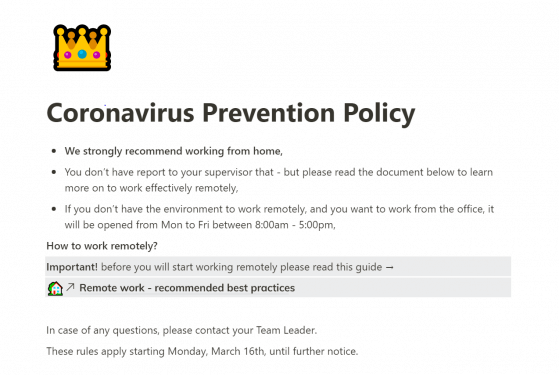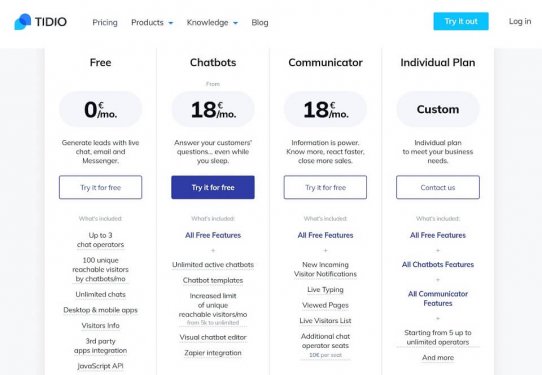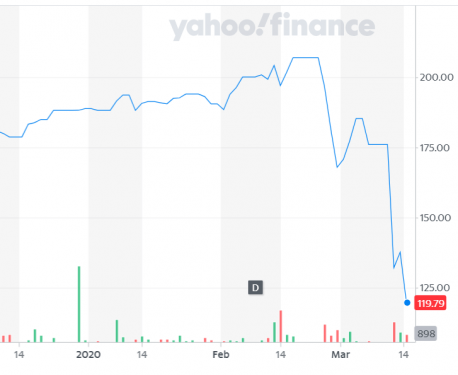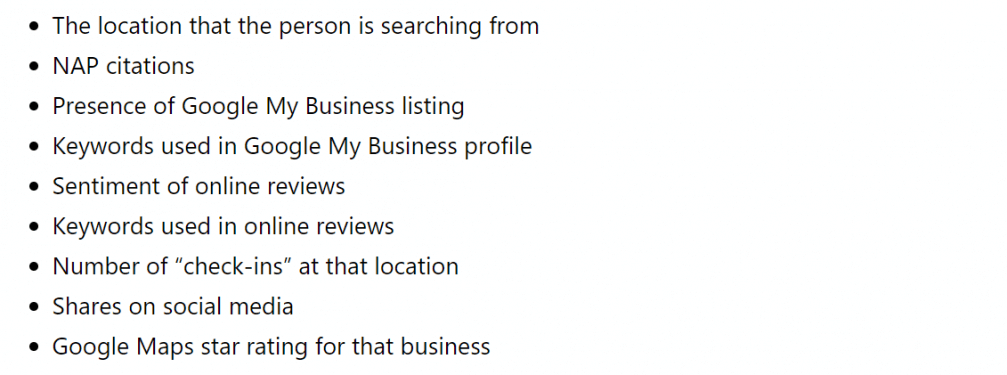There is no doubt that the world is in a difficult place right now.
The rapid spread of the Covid-19 virus, commonly known as “coronavirus” will impact all of us, no matter the location. From the economical standpoint, we might be on the verge of massive transformations which consequences will be visible for the months and years to come.
Many countries are on lockdown, closing their borders and shutting down public places and places of work. Conferences and events have been cancelled and some of them have moved online. Along with this, we are observing the ever-increasing number of businesses closing down or having to move their services online.
Taking a look at the data, 93% of surveyed businesses have already noticed a negative impact on their financial performance in 2020. For many industries, the numbers are likely to only get worse.
This is why we’d like to suggest 6 useful tips that your company can implement right away in order to minimize the potentially detrimental consequences of the coronavirus situation.
Move your business fully online, and do it fast.
If you had to shut down your physical store, office or gym and are counting days until this madness is over – stop. Being proactive is the way to go if you want your business to survive, and even thrive, despite the chaos.
Time is of the essence here and you have to act fast. Developing a perfect website from scratch, getting a new logo or taking outstanding product pictures can look like an overwhelming task, and that’s because it is.
However, don’t get stuck thinking that’s the only choice you’ve got.
In fact, creating a decent landing page for your services or setting up an online store can be done overnight. Phew! You can do it within a few hours. No coding required!
How?
- For setting up an online shop, use a platform such as BigCommerce, Shopify or Etsy
- For selling items directly, consider marketplaces such as Amazon or Ebay
- For providing services, you can build a website with WordPress, Wix or Weebly
- Integrate a solid blog strategy with your site for more options like affiliate marketing, online branding, etc.
We won’t go into technical details, but use these resources to get started right away:
- Beginner’s Guide to Building a Shopify Store from Scratch
- Selling Online Through Marketplaces: A Beginner’s Guide
- How to Choose the Best Blogging Platform in 2024
If you are not convinced yet, here’s why choosing a platform-based solution is the best option right now for any business that wants to go online:
- Quick and easy set up (only a few hours!)
- Free, ready-to-use templates
- Cheaper than custom-built websites
- In-built tools for optimization
- Reduced maintenance costs
- Readily available hosting support
Don’t wait, act. Almost every business can operate online, at least partially. It’s all about being creative and proactive in how you set up your processes.
For example, using Brosix, you can organize your team’s remote work hassle-free. Setting up a system in which your team can seamlessly communicate via chat, audio or video, from any device, share files and integrate with other apps to automate the information flow is a foundation for successful remote work.
Here’s how the tool looks like from the inside:

And now take a look at these 3 real-life cases of physical businesses that successfully went fully online during the coronavirus pandemic shutdown.
1. Yoga studio
Hotpod Yoga Studio run by 34-year-old Meegan Bradley had to close due to the coronavirus outbreak. But instead of waiting to reopen, Meegan has used Zoom technology to move all her classes online. She quickly created a website and offered her customers three options: live-streaming yoga classes priced between £2-£8, web video series, and one-to-one sessions online for about £30.

Image source: MeeganBradley.com
With more than 30 people attending each session, she might not only succeed with a transition but also manage to scale her business since the number of class participants is no longer limited by the studio’s physical space.
2. Bookshop and cafe
The owners of Mainstreet Trading Company running a bookshop and a cafe in the UK had to be really creative in searching for solutions during the pandemic. They have decided to take a risk and open an online shop selling their books.

Image source: https://www.mainstreetbooks.co.uk/
As they confirm, their community turned out to be very supportive also before the store went live – ordering books via email and phone. Where there is a will, there is a way, right?!
3. Garden design business
Another example is a garden design company run by Jack Wallington in London. Since most of his projects have been postponed or cancelled, he has decided to move online and offer his clients virtually designed tours of their gardens.

Image source: https://www.jackwallington.com/
Moreover, Jack started promoting his first gardening book and exploring different revenue streams with online courses. He is considering creating one for people wishing to learn more about growing vegetables and herbs. With easy access to platforms such as LearnWorlds, it’s becoming easy to sell your knowledge or skills in the form of a course.
Pro tip: If you run a business in a severely affected industry, such as tourism (hotels, travel agency, etc. ) or beauty (hairdresser, facial treatments, etc.) you can start a blog, vlog, create an ebook, or sell your discounted services as vouchers for the future use.
Take care of your employees = health and safety first
Taking your business online also means that there will be plenty of work that needs to be done.
From setting up a store, handling customers’ queries, and posting updates on social media to contacting your business partners and sending out packages, your employees play a key part in ensuring that your business runs smoothly.
Closing workplaces is a challenge if your employees aren’t used to working remotely. But there is always a way to make things work. With the use of technology, most tasks related to business operations can be handled online, so that your employees can do their work from their homes.
However, it’s important that you assist them with that transition as much as possible. One way to approach this is to create a written document – prevention policy outlining steps a company and its employees need to take in order to be safe.
Here’s an example of such a document created in Notion.

Image source: Notion
Each business ought to approach this process in accordance with what works best for them, but one thing is universal: the health and safety of your employees should be your priority.
And here’s a quick guide to best practices for making your team prepared for the situation:
- If working in the office – equip it with sufficient sanitary products: soaps, hand sanitizers, face masks.
- Print out posters reminding employees to keep hygiene levels high, especially washing hands.
- Limit the number of meetings or move them online
- Work remotely if possible
- Prepare a health and safety policy for everyone to follow
The good news is that modern technology allows for teams to work remotely without compromising their productivity or the quality of their work. All you need is the right toolset. Take a look at some of the tools that you can use for free to streamline remote work for your employees:
- Internal communication: Brosix
- Documents sharing: Google Drive or Dropbox
- Online meetings: Zoom or Google Hangouts
- Customer communication: Tidio Live Chat or Drift
- Product demos or tutorials: Loom or BreadnBeyond
Pro tip: In case, you need to on-board new hires remotely, check out this in-depth guide on how to perform remote onboarding as smoothly as possible
Seek out government support and cut down expenses
In times of a crisis, asking for help is not optional, but rather what every responsible business owner should do. Since the coronavirus outbreak has become a global issue, plenty of governments, organizations and independent businesses have offered help in fighting the crisis.
As a business owner, you should not stay behind, but rather proactively seek out ways to help your business stay afloat.
Government
Depending on the country you operate in, your government might have already come up with projects, programs or loan schemes to support you and your fellow entrepreneurs. Research the official website of your government to find out more details.
The support might be aimed at helping you cover expenses if your revenue is frozen, your employees took sick leave or you have to pay refunds. The help your government can offer might vary from tax relief through loans to paying out directly with no need for returning the capital.
If you run a US-based business, you can read more about your options on the website of the U.S. Small Business Administration and Capital One:
- Small Business Guidance & Loan Resources
- Assistance for Customers Impacted by the COVID-19 Virus Situation
Cutting down expenses
Another way to find some financial relief for your business is to focus on cutting down your costs. Now, before you consider human resources (your employees) to be the biggest cost that you should get rid of, hold on with your decisions.
There are other ways you can reduce costs during the crisis. One of them is looking for unnecessary expenses, such as rarely used apps, gym memberships for your employees or other benefits that you can suspend.
Apart from this, it’s important to check in with your service providers whether they are able to offer you discounts or free access during the pandemic. There are plenty of companies that have decided to give back to the community during the crisis.
Brosix is also one of them, offering a 3 month free trial for all businesses that had to start working remotely due to the Covid-19 outbreak. All you have to do to sign up is go to this page.

Try it out for your team to make their work more productive and collaborative.
Also, here’s an example of SocialPilot that has prepared a special offer for businesses scheduling posts on social media. They are offering their service only for the symbolic $1 per month instead of regular $50.

Another company offering similar solutions is Spotler CRM (formerly Really Simple Systems), a CRM platform offering free packages for using their services.
Tidio Live Chat, on the other hand, has decided to offer not only free access to their live chat (forever), but also a custom plan for businesses that want to adjust the tool to their individual needs, especially during the pandemic.

Pro tip: Here’s a compilation of awesome tech tools that you can use during the coronavirus crisis: Tech Tools to Keep Your Team Connected during COVID-19.
Move online but stay “local” (and use it to your advantage)
Even though the situation is a challenging one, there is always a silver lining to be noticed. We might observe detrimental short-term consequences but in the long-term it can prove to be a valuable test for small businesses that might later on also benefit the local economy.
Let me be perfectly clear when I say that the situation is extremely difficult and I would never wish for small business to go through a similar thing again. Yet, we all have to look for positives and things to learn from.
With more and more countries on a lockdown, supply chains have become strained. With many factories closed down as well as import and export restrictions, the majority of retail businesses will suffer.
However, the negative impact of such a situation can be minimized and avoided in the future by taking a few steps right now:
- Get in touch and collaborate with local providers
- Diversify your suppliers portfolio
- Partner up with other businesses on promotions, vouchers etc. to keep the liquidity of your business’s finance
- Go with your services and products online
In fact, if you are running a small business and want to market to your local audience, there has never been a better time to do it. Let me tell you why.
The chance that the Coronavirus will transmit through a parcel that has been shipped for several days from China is extremely low. But take a look at the stock price of the company that owns Corona (the beer brand):

Image source: Yahoo Finance
Even though the beer brand has no connection with the actual virus (it’s produced in Mexico that hasn’t even been mentioned much in the news related to Covid-19 spread), the company has taken a severe hit on the market.
Here are a few things that you should keep in mind when going online as a local business.
Leverage the power of local SEO
If you want your shop to be ranking on the first pages of Google for people from your neighbourhood, you have to level up your local SEO game. Luckily, nowadays Google is really supportive of local businesses.
It makes sense, as more than 46% of Google searches have “local intent”.
Take a look at the local SEO ranking factors outlined by Backlinko.
 Source: Backlinko
Source: Backlinko
Truth is, the topic of SEO is a complex one, however there is nothing that cannot be mastered if you put time and effort into doing so. In fact, the world’s lockdown made it easier and cheaper to access this kind of knowledge. Check out this awesome list of digital marketing courses (including SEO) that you can complete during your quarantine to grow you business.
Omnichannel online customer communication
Once you operate solely online your channels for customer communication should change, too. Sure, you can still be available via phone, but this form of customer support isn’t really scaleable.
Instead, consider installing a live chat as well as adding chatbots to your website. Here’s why:
- It allows you to answer customer’s queries in real-time
- Your email inbox won’t get overfilled
- Automated customer support saves your time
- You won’t miss any messages that sometimes end up in SPAM
- Live chat is more convenient than back-and-forth email exchange
- Chatbots allow you to automatically track, tag and segment your website’s visitors
- You will get insights into your audience’s behaviour on your page
During the pandemic period you might expect an increased number of customer queries coming your way. Your business should be prepared to handle it. If you decide to rely solely on email communication, make sure to set up email verification processes and automated email responses to save your time.
By being readily available to your customers across many channels, you are sending them a message saying that you see and care about them and their issues, no matter the situation.
Use vouchers, giveaways, promotions
You can keep your business’s financial liquidity stable by launching and selling vouchers and promotions that your customers can redeem in the future.
Such promotions are also great for boosting your brand’s awareness and building trust between your business and your customers. There are plenty of loyalty programs ideas you can implement. Identify which one can work for your brand by doing competitor’s research and keep every resource in a single place for effective project management.
It’s become a common practice for SPA centers, massage therapists or hairdressers who are promoting such options on their social media. By doing this, your cash flow is not frozen and you are able to keep your business running and paying your expenses without going into debt.
To automate the process of distributing vouchers or discounts you can use chatbots. Here’s how it looks in practice:

Many people want to shop locally to support their community and in times like this, it’s also the only choice they have. Don’t take advantage of it by raising your prices, but rather use it to meet your customers halfway and build new relationships.
Host Events Online
People have more free time than ever right now and are spending a lot of time online. Use this as an opportunity to interact with your audience by hosting live events online, like webinars. You might also try automated webinars if you want to make your events more easily available for people to attend. Webinars will keep you top of mind with your current customers and help you find and build relationships with new ones.
Remember your shipment tracking and return & refund workflow
Every day we hear about more and more restrictions put on all the industries due to the coronavirus pandemic.
With closed shopping centers and boutiques, retail will suffer. Empty shelves in supermarkets observed right after strict government restrictions also meant increased traffic in other eCommerce stores, for example those selling healthcare products. With shortages in factories, you might experience delays from your suppliers.
In consequence, you might not be able to deliver your customers their ordered goods on time. It’s crucial that you track shipments and communicate to your clients about any possible issues. Here are two situations you have to get ready for during the pandemic:
1. Customers will ask you about the status of their purchases all the time.
In order to handle all customer queries, you might need to automate your customer support, for example using live chat or chatbots. A good idea is to also let your audience know about it in advance, for example using social media.
Here’s an example of how to handle it using Instagram.

Image source: Instagram
Of course, you can also use emails to inform your audience about the situation. Make sure to equip yourself with a reliable email marketing software to avoid any issues with email deliverability. Or if you want to take things to the next level, consider using a virtual call center software to reach out to your customers easily via phone calls. This way things won’t only be easier and time-savvy, but also give the essence of personalization to your audience with a feeling of being cared for by your brand.
2. Online shoppers can return everything (and you should expect refunds)
That’s the rule. When selling online, you can’t just point to a “no refunds” sticker in your store. If something is bought online customers can return it without any reason. With a much smaller revenue, refunds can be a serious blow to small businesses already struggling during the crisis.
Here, again it’s important to have an automated process in place, for example by using chatbots or assigning a person responsible for handling refunds and returns.
All in all, make sure to introduce a solid inventory management system in place in order to avoid issues and miscommunication with your staff.
Stay transparent and available to your customers
In the times of crisis, two things matter most when it comes to providing excellent customer service: availability and radical honesty.
By being transparent and keeping your customers up-to-date with regards to your business’s operations you can strengthen your reputation as well as build long-lasting relationships and trust with your audience.
Difficult times will require making difficult decisions and implementing drastic measures, and it’s up to you how to integrate and communicate them to your customers.
One thing is certain: The faster, the better.
Just take a look at some statistics related to customer service:
- 50% of customers have left a brand for a competitor who was able to stay more relevant and better satisfy their needs
- Businesses can grow revenues between 4% and 8% above their market when they prioritize better customer service experiences
- 40% of customers want customer service reps to take care of their needs faster
- 90% of customers rate an “immediate” response as important or very important when they have a customer service question. 60% of customers define “immediate” as 10 minutes or less.
As you can see, the way you treat your customers, especially in the times of crisis, is crucial to your business’s reputation and its success. React fast and be honest about what you plan to do, and I assure you that your customers will pay you back by supporting your business.
For example, look at this announcement made by Formaggio Italiano restaurant that has decided to support their staff by offering the $5 delivery option to cover the salary of servers who temporarily take on the roles of delivery drivers.

Image source: Facebook
That is a great gesture towards both: employees who will still be employed and earn money and customers who will get served. As you can see, it got shared 111 times and the community has expressed its support.
Truth is, by now you should have prepared a response to the Covid-19 pandemic. Anything is good enough – creating a social media post, recording a youtube video, sending out newsletter announcements or even building a seperate landing page outlining the steps you are taking in the light of the crisis.
Don’t wait for your competitors to steal your customers with outstanding and immediate customer service and communication and be the one to live up to your customers’ expectations, especially in such challenging times. Don’t lose your customers’ trust when there is so much at stake.
Conclusion
The spread of Covid-19 is bound to change the world of business for months (or even years) to come.
That doesn’t mean that your business must suffer consequences for the long-run. On the contrary, by going fully online, implementing practical solutions as presented above, and being transparent with your audience, your business will not only survive, but also thrive despite the pandemic.






